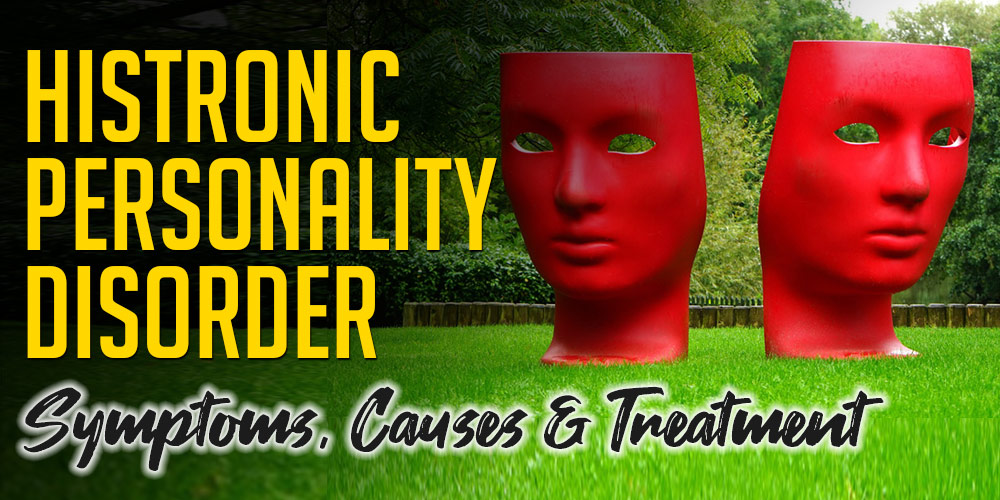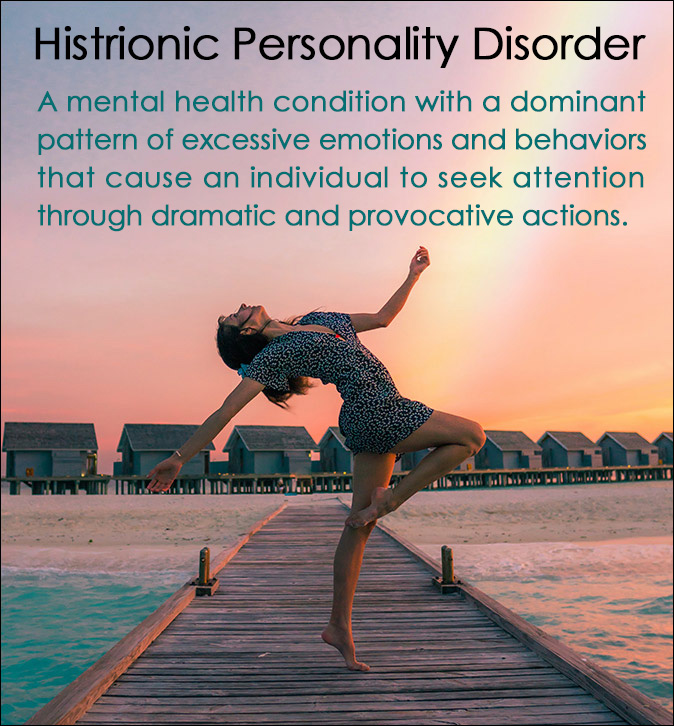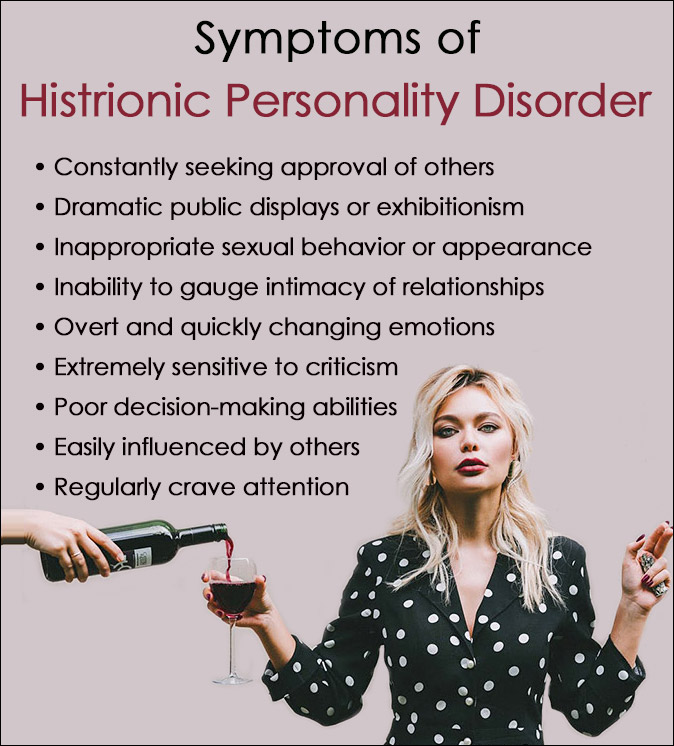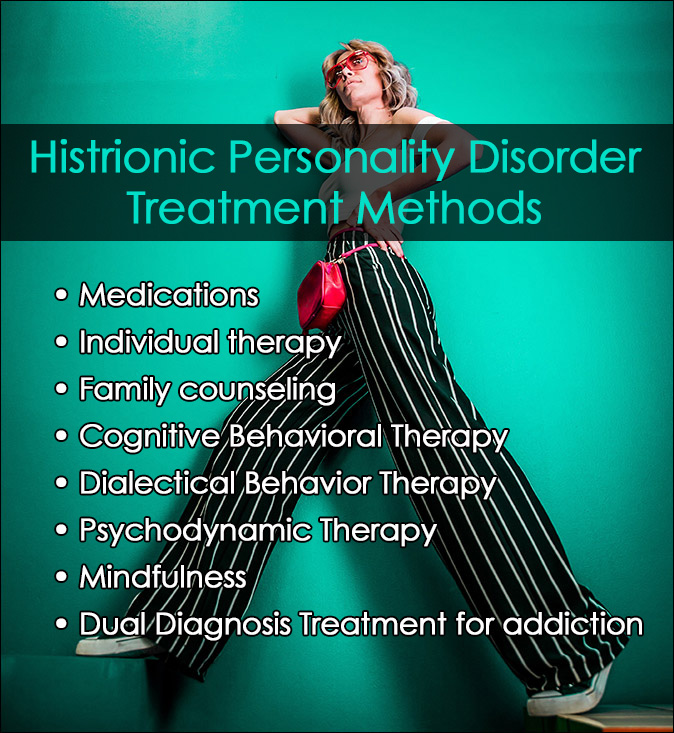
The public often misunderstands personality disorders, and many people living with the condition are unable to recognize it when presented with the evidence. This is especially true in the case of Histrionic Personality Disorder (HPD).
As many as 15 percent of adults deal with some type of personality disorder.
Research suggests that around 2 to 3 percent of people have histrionic personality disorder, though it’s difficult to know for sure because of the very nature of the condition.
As mentioned, HPD tends to be ego-syntonic, which means people with the disorder might see their behavior as normal, and fail to identify or report any symptoms.
Unfortunately, many people with HPD may never seek treatment even though the disorder can lead to impaired quality of life.
About Histrionic Personality Disorder
Merriam-Webster defines Histrionic is defined as deliberately affected, overly dramatic or emotional.
Histrionic Personality Disorder is defined as a mental health condition with a dominant pattern of excessive emotions and behaviors that cause an individual to seek attention through dramatic and provocative actions.
Histrionic Personality Disorder is associated with psychological disorders referred to as Cluster B personality disorders. This group of disorders tends to display personality types that seem unpredictable, emotional, and dramatic.

People with HPD often have a very chaotic inner-life where they measure their self-esteem on the approval of others. This is more than simply feeling peer-pressure because it can drive attention-seeking behaviors that are self-destructive.
Some of the unhealthy behaviors associated with HPD include substance abuse, impulsive and unsafe sexual activity, and taking other unnecessary risks.
Relationships can also be s problem for those with histrionic personality disorder because they believe they are much more intimately connected to a person than they are in reality. This can lead to habitually unstable relationships, severe anxiety, and depression.
Many people living with HPD actually function quite well in normal society and may even display exceptional people or social skills, except in the case of intimate personal relationships.
However, if anxiety about their place in the world or self-worth escalates, they will act out by manipulating others emotionally, engaging in self-destructive behaviors, and be at an increased risk for suicidal gestures.
Causes of Histrionic Personality Disorder
It’s not entirely clear why some people develop HPD and others do not. Researchers attribute the condition to a combination of genetic and environmental factors.
A person with a family history of personality disorders is more likely to develop the disorder than a person without any medical history of this type of mental health condition.
Environmental factors may include a person who grew up in a household where histrionic personality disorder behaviors were on display and seen as normal.
Children who were denied positive reinforcement or were rewarded with attention for emotional or dramatic behavior can potentially develop HPD tendencies to get noticed by adults in their life.
Whatever the cause of histrionic personality disorder, it’s typically not until early adulthood that many of the symptoms will become a serious problem.

Histrionic Personality Disorder Symptoms
Histrionic personality disorder symptoms can appear to others as unusual quirks or socially awkward characteristics. A person living with this disorder is likely dealing with some form of mental and emotional turmoil.
The symptoms may present as being bored easily, acting impulsively without thought or regard for others, or threatening to cause self-harm.
Common HPD Symptoms
- Constantly seeking approval of others
- Dramatic and theatrical public displays or exhibitionism
- Inappropriate sexual behavior or appearance
- Extremely sensitive to criticism
- Regularly crave attention
- Overt, excessive emotions that can change quickly
- Easily influenced by the actions or opinions of others
- Inability to properly gauge the intimacy of relationships
- Poor decision-making abilities
Diagnostic Criteria for Histrionic Personality Disorder
The DSM 5 diagnostic criteria for histrionic personality disorder requires at least five or more symptoms from a list of eight for a diagnosis of HPD.
5 of the following symptoms are necessary for a diagnosis of HPD:
- A highly suggestible personality, meaning easily influenced by circumstances or others around them that they consider important
- Uncomfortable in settings where they are not the center of attention or the life of the party
- Regularly uses their physical body to draw attention to themselves
- Uses inappropriately provocative or sexual behavior to get attention
- Has the tendency to think relationships are more intimate than they are
- Displays outsized expressions of emotion, dramatics, and theatricality
- A style of speech that lacks detail and is influenced by those around them
- Exhibits shallow expressions of emotion that shift rapidly
It should be noted that HPD can also coexist with other mental health issues such as anxiety, eating disorders, or depression and addiction. Other personality disorders like narcissistic, borderline, or antisocial might also occur simultaneously.
While getting people that display these symptoms to seek help and accept treatment can be difficult, there are therapeutic approaches that can be effective.

Histrionic Personality Disorder Treatments
Histrionic personality disorder treatments can include individual, group, or family psychotherapy and sometimes medication to treat some of the symptoms.
- Medications
- Individual therapy
- Family counseling
- Cognitive Behavioral Therapy
- Dialectical Behavior Therapy
- Psychodynamic Therapy
- Mindfulness
- Dual Diagnosis Treatment for addiction
Medications are sometimes necessary because people with HPD are at a greater risk for anxiety or depression that can affect their work, goals, and relationships.
Medications like antidepressants or anti-anxiety meds can be effective for related symptoms of depression or anxiety that often accompany histrionic personality disorder, although they don’t treat the disorder directly.
One-on-one therapy and family counseling can help a person examine many of the underlying causes of the disorder and develop skills to better relate to others in a more positive way.
Counseling and therapy might also focus on failed intimate relationships that could be causing depression or anxiety.
Cognitive Behavioral Therapy and Dialectical Behavior Therapy can be effective for exploring the connection between thoughts, emotions, and behavior to develop coping strategies.
Holistic therapies like Mindfulness can reduce anxiety and boost emotional self-awareness.
For co-occurring mental health issues combined with substance use and addiction, dual diagnosis treatment may be necessary. It’s important that both HPD and substance addiction are addressed together because the symptoms of one will worsen the other condition.
With support and proper treatment, people struggling with histrionic personality disorder can lead healthy and productive lives.
Frequently Asked Questions
How common is histrionic personality disorder?
All types of personality disorders combined affect approximately 9 percent to 15 percent of adults, although HPD makes up less than 2 percent of all cases.
It was once thought to occur more frequently in women, but the actual numbers are probably equal for men.
Is histrionic personality disorder hereditary?
While there isn’t a specific gene responsible for histrionic personality disorder, it does tend to run in families suggesting a hereditary predisposition.
Environmental factors related to the home conditions and family circumstances also play a role in the development of the disorder.
How does HPD develop?
Genetics, environment, and psychological factors all contribute to the development of HPD.
A family history of various types of mental illness, including personality disorders, anxiety, and depression heighten the risk of development.
Learned behavior from parents, caregivers, and other family members has a big impact on emotions and personality traits.
Adverse childhood events such as abuse or neglect can also increase the risk of developing the disorder.
The development of HPD often appears in adolescence and the early adult years and will continue into adulthood unless the symptoms are addressed through treatment.
Are codependent relationships common with HPD?
Yes, codependent relationships and an intense need for attention are common traits associated with histrionic personality disorder.
Some people with HPD have a fear of being abandoned and use manipulation tactics for reassurance.
One person in the relationship is usually responsible for enabling the unhealthy behavior of another to their own detriment.
The need for validation and control make it difficult for people with HPD to have healthy relationships.
What therapy works best for histrionic personality disorder?
Cognitive Behavioral Therapy and Dialectical Behavior Therapy are two of the most widely used and effective treatment approaches for histrionic personality disorder.
These therapies address thoughts, emotions, and behaviors and teach coping skills to challenge negative thinking and manage emotions and relationships.
Medications can be helpful for treating symptoms like anxiety and depression, but they do not directly address the core roots of the disorder.
How do I know if I have histrionic personality disorder?
Because of the ego-syntonic nature of personality disorders like HPD, it can be difficult to perceive the symptoms in oneself.
However, recognizing the following signs could signify the disorder is an issue:
- Overtly dramatic behavior
- Intense need to be the center of attention
- Extreme mood changes
- Dramatic and seductive dress and appearance
- Easily influenced by others
- Relationship and intimacy issues
- Sexually flirtatious demeanor
Is substance addiction common with histrionic personality disorder?
Substance use and addiction are most common with antisocial and borderline personality disorders, although it also frequently occurs with histrionic personality disorder.
Dual Diagnosis Treatment is recommended for the most effective recovery when both HPD and addiction occur together.
Related Posts
- Alcohol Dementia Causes, Symptoms and Treatment
Note: Alcohol Dementia goes by many names including, alcohol-related dementia, alcoholic dementia, and alcohol-induced dementia.…
- Alcoholic Neuropathy Symptoms, Causes and Treatment
Excessive alcohol consumption, especially for long-term drinkers, can create a host of difficult health issues.…
- Obsessive Compulsive Personality Disorder / OCD
The term Obsessive Compulsive Disorder / OCD is often used casually in conversation, however, it’s a…
